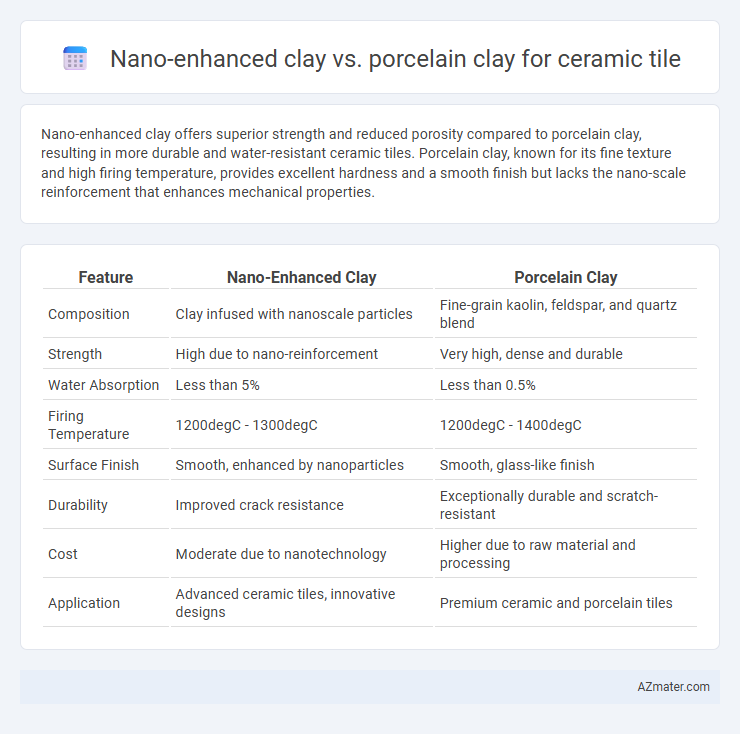Nano-enhanced clay offers superior strength and reduced porosity compared to porcelain clay, resulting in more durable and water-resistant ceramic tiles. Porcelain clay, known for its fine texture and high firing temperature, provides excellent hardness and a smooth finish but lacks the nano-scale reinforcement that enhances mechanical properties.
Table of Comparison
| Feature | Nano-Enhanced Clay | Porcelain Clay |
|---|---|---|
| Composition | Clay infused with nanoscale particles | Fine-grain kaolin, feldspar, and quartz blend |
| Strength | High due to nano-reinforcement | Very high, dense and durable |
| Water Absorption | Less than 5% | Less than 0.5% |
| Firing Temperature | 1200degC - 1300degC | 1200degC - 1400degC |
| Surface Finish | Smooth, enhanced by nanoparticles | Smooth, glass-like finish |
| Durability | Improved crack resistance | Exceptionally durable and scratch-resistant |
| Cost | Moderate due to nanotechnology | Higher due to raw material and processing |
| Application | Advanced ceramic tiles, innovative designs | Premium ceramic and porcelain tiles |
Introduction to Ceramic Tile Materials
Nano-enhanced clay incorporates nanoparticles to improve mechanical strength and durability, making it highly resistant to cracks and wear in ceramic tiles. Porcelain clay, composed of kaolin, feldspar, and quartz, is prized for its density and low porosity, resulting in a hard, water-resistant tile ideal for both indoor and outdoor use. Understanding these materials helps optimize tile performance by balancing strength, water absorption, and aesthetic qualities.
Composition of Nano-enhanced Clay
Nano-enhanced clay for ceramic tiles incorporates nanoparticles such as silica, alumina, or titanium dioxide, which improve mechanical strength, durability, and resistance to cracking compared to traditional porcelain clay. These nanoparticles create a denser microstructure by filling the voids between clay particles, enhancing the overall performance of the tile under thermal and mechanical stress. In contrast, porcelain clay mainly consists of kaolin, feldspar, and quartz, featuring coarser particles that provide strength but lack the fine-scale reinforcement seen in nano-enhanced formulations.
Porcelain Clay: Properties and Traditional Uses
Porcelain clay is characterized by its high density, low porosity, and superior strength, making it ideal for durable ceramic tiles that resist moisture and wear. Its fine particle size and high kaolin content result in a smooth, white surface after firing, preferred in both traditional and modern architectural applications. Nano-enhanced clay, while offering improved mechanical properties and faster sintering, generally complements porcelain clay by enhancing specific performance criteria without replacing the established reliability of porcelain materials.
Manufacturing Process Differences
Nano-enhanced clay incorporates nanoparticles into the raw material mix, resulting in improved plasticity and faster drying times compared to traditional porcelain clay. Porcelain clay typically requires higher firing temperatures around 1200-1400degC to achieve its dense, vitrified structure, while nano-enhanced clay can achieve similar or superior strength at slightly lower temperatures due to enhanced particle bonding. The manufacturing process for nano-enhanced clay involves precise dispersion of nanoparticles for uniformity, whereas porcelain clay production relies more on controlled particle size distribution and mineral purity.
Mechanical Strength and Durability
Nano-enhanced clay ceramics exhibit superior mechanical strength compared to traditional porcelain clay, due to the incorporation of nanoparticles which enhance particle packing and reduce micro-cracks. This improvement results in higher flexural strength and increased resistance to wear and impact, making nano-enhanced clay tiles more durable in high-traffic applications. Porcelain clay, while known for its density and low porosity, generally offers lower toughness and is more prone to brittle failure under mechanical stress.
Water Absorption and Porosity Comparison
Nano-enhanced clay significantly reduces water absorption rates in ceramic tiles due to its ultra-fine particle size, which fills microscopic voids more effectively compared to traditional porcelain clay. Porcelain clay, while known for its low porosity and durability, typically exhibits higher water absorption than nano-enhanced formulations, resulting in less resistance to moisture penetration. The superior compactness and reduced porosity of nano-enhanced clay improve tile longevity and performance in humid environments by limiting water ingress and associated structural damage.
Surface Finish and Aesthetic Qualities
Nano-enhanced clay offers a smoother surface finish with increased uniformity and reduced porosity, resulting in higher gloss and enhanced durability compared to traditional porcelain clay. Porcelain clay provides a denser, harder body that resists scratches and stains but may exhibit a more matte finish due to its coarse particle structure. The nano-enhancements optimize aesthetic qualities by delivering finer textures and more vibrant color retention, making it ideal for premium ceramic tile applications.
Environmental Impact and Sustainability
Nano-enhanced clay reduces water and energy consumption during production due to its improved plasticity and firing efficiency, resulting in lower carbon emissions compared to traditional porcelain clay. Porcelain clay, while durable and low-porosity, typically requires higher firing temperatures, increasing energy use and environmental footprint. The sustainable advantage of nano-enhanced clay lies in its ability to incorporate recycled materials and reduce raw material extraction, contributing to circular economy goals in ceramic tile manufacturing.
Cost Analysis: Nano-enhanced vs Porcelain Clay
Nano-enhanced clay offers a competitive cost advantage over traditional porcelain clay due to lower raw material expenses and reduced energy consumption during firing. Porcelain clay's higher density and longer kiln cycles increase production costs, making it less economical for large-scale tile manufacturing. The integration of nanoparticles in nano-enhanced clay also improves durability and performance, potentially lowering long-term maintenance costs compared to porcelain tiles.
Future Trends in Ceramic Tile Technology
Nano-enhanced clay offers superior durability, enhanced mechanical strength, and improved water resistance compared to traditional porcelain clay, making it a promising material for next-generation ceramic tiles. Advances in nanotechnology enable the integration of nanoparticles to optimize tile performance, such as self-cleaning properties and increased scratch resistance, driving innovation in sustainable and smart ceramic tile solutions. Future trends emphasize eco-friendly production processes and multifunctional tiles that combine aesthetic appeal with high-performance nanomaterials for enhanced longevity and environmental impact reduction.

Infographic: Nano-enhanced clay vs Porcelain clay for Ceramic tile
 azmater.com
azmater.com